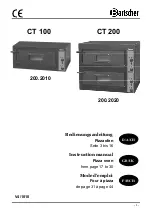
6
If desired, fruit can be pretreated to preserve its natural color. Add 1½ teaspoons of lemon juice to each 1½ cups puréed fruit. See the Fruit
Drying Guide to determine which fruits will benefit from pretreatment.
The natural sweetness of fruit is intensified with drying. However, if your preference is for a sweeter fruit roll, you can add honey, maple
syrup, corn syrup, or sugar to the puréed fruit. Try different amounts of sweeteners, starting with 1 tablespoon for each 1½ cups of fruit purée,
to find your preference. Fruit with sweeteners added will take longer to dry than fruit that is not sweetened.
Canned fruit can also be used to easily make fruit leather. Drain juice from fruit, saving juice for later use. Place fruit in food processor or
blender and purée until smooth. Applesauce can be used directly from the container.
For frozen fruit, thaw and purée until smooth.
While lightly oiled fruit roll sheet is sitting on the counter, pour puréed fruit onto it. Spread with a spatula to form a uniform layer about ¼
inch thick. Position filled fruit roll sheet on dehydrator tray and then place tray onto power base, being careful not to spill the fruit purée onto
the base. Begin drying. Average drying time for all fruit rolls is 4 to 7 hours.
Determining Dryness
Acceptably dried fruit leather will be slightly tacky to the touch, but will not indent when touched in the center. Begin checking the fruit roll
after 4 hours of drying. If additional drying time is needed, recheck every 30 minutes.
While slightly warm, starting from the outer edge, carefully peel the fruit roll from the sheet. Loosely roll in plastic wrap or waxed paper and
follow “Packaging and Storing Dried Food” information on page 8. For immediate enjoyment, cut in strips or roll and cut into serving pieces.
Note:
Remove fruit rolls from sheets prior to cutting them.
Fruit Drying Guide
Drying times are highly variable and dependant on the type and amount of food, thickness, evenness of food pieces, humidity, air temperature, personal
preference, and the age of the plant at the time of harvesting.
Fruit
Preparation
Pretreatment
Average Drying Time
Apples
Peel, if desired, core, and cut in rings or slices, ⅛˝ to ¼˝
thick.
Ascorbic acid, ascorbic acid
mixture, or lemon juice.
3–8 hours
Apricots
Cut in half, remove pit, and cut in quarters or ¼˝ thick
slices.
See apples.
7–15 hours
Bananas
Peel and cut into ¼˝ thick slices.
See apples.
5–7 hours
Blueberries
Remove stems. Dip in boiling water for 30 to 60 seconds
and then plunge in ice water to crack the skin.
None
8–16 hours
Cherries
Remove stems and pit. Cut in half, chop, or leave whole.
None
14–22 hours
Cranberries
Remove stems. Dip in boiling water for 30 to 60 seconds
and then plunge in ice water to crack the skin.
None
9–17 hours
Figs
Remove stems. Small figs can be left whole. Otherwise,
cut in half. Dip whole figs in boiling water for 30 to 60
seconds and then plunge in ice water to crack the skin.
None
7–14 hours
Grapes
Leave whole or cut in half. Dip whole grapes in boiling
water for 30 to 60 seconds and then plunge in ice water
to crack the skin.
None
12–20 hours
Kiwi
Peel and cut into ¼˝ to ⅜˝ thick slices.
None
3–5 hours
Nectarines
Cut in half and remove pit. May also quarter or slice ¼˝
thick.
See apples.
5–9 hours (slices)
36–48 hours (halves/quarters)
Peaches
Peel if desired. Cut in half and remove pit. May also
quarter or slice ¼˝ thick.
See apples.
5–9 hours (slices)
36–48 hours (halves/quarters)
Pears
Peel, core, and slice ¼˝ thick.
See apples.
6–12 hours
Pineapple
Peel, core, and slice ¼˝ thick.
None
7–11 hours
Plums/Prunes
Halve or quarter and remove pit.
None
7–14 hours
Rhubarb
Trim and discard leaves. Cut stalk into ¼˝ slices.
None
5–8 hours
Strawberries
Remove the leafy crown. Halve or slice ¼˝ thick.
None
5–11 hours




























